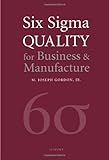Six Sigma Quality for Business and Manufacture
Six Sigma is Business and Industry’s newest recognized quality program. This text provides information and instructions for new and current quality professionals in order to help employ methods to attain Six Sigma defect quality assurance within their company.
All areas of business and manufacture are covered. Detailed checklists, questionnaires and forms assist personnel in developing their own programs to ‘prevent’ problems from occurring and to solve new and long-term problems in services and manufacturing. Examples and formulae are provided for use to determine if, when and then how much a process may be adjusted for reaching higher quality assurance levels. Knowledgeable readers will be able to use this comprehensive text immediately in the workplace.
List Price: $ 285.00
Price: $ 79.94
Check This:
 The Six Sigma Black Belt Handbook
The Six Sigma Black Belt HandbookThe Six Sigma Operational Methods Series goes beyond simply explaining Six Sigma basics to interested managers–these are hard-cor…
 The Black Belt Memory Jogger: A Pocket Guide for Six Sigma Success
The Black Belt Memory Jogger: A Pocket Guide for Six Sigma SuccessA low cost tool that can bring you Six Sigma success. Help all of your Black Belts become the teachers, mentors, and leaders you k…




Very Practical Approach,
The phrase “Six Sigma” derives from assuming a Normal distribution of some random variable that you are measuring. This distribution has a standard deviation, sigma. Then, if you measure the area under the curve that is greater than 6*sigma from the mean, you get something like under 10^-6. So the idea is that if you make something with a property that can vary from item to item, you want to reduce the deviation so that all items within 6*sigma of the mean are acceptable. And thus, unacceptable items are less than one in a million.
Of course, if the distribution is not Normal, then this is not necessarily true. In this case, Six Sigma is used metaphorically. The basic idea is the same.
The Six Sigma approach has been widely publicised in recent years. Perhaps the best known proponent in the United States is Motorola, who claimed that they successfully applied it to their manufacturing operations. Especially those for cellphones and microprocessors.
Perhaps its greatest merit is that it stresses hard numerical criteria that are easily and economically measurable. So that you can conduct these measurements on a large subset of the items you are making. Or indeed perhaps on all the items.
Was this review helpful to you?

|